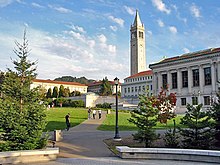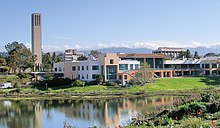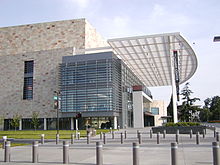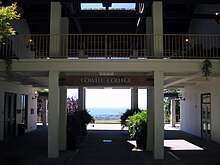The University of California (UC) is a public university system in the U.S. state of California. Under the California Master Plan for Higher Education, the University of California is a part of the state's three-system public higher education plan, which also includes the California State University system and the California Community Colleges System.
Governed by a semi-autonomous Board of Regents, the University of California has 10 campuses, a combined student body of 238,700 students, 19,700 faculty members, 135,900 staff members and over 1.6 million living alumni as of spring 2015.[2]
The University of California was founded in 1868 in Berkeley, California. Its tenth and newest campus, UC Merced, opened for classes in fall 2005. Nine campuses enroll both undergraduate and graduate students; one campus, UC San Francisco, enrolls only graduate and professional students in the medical and health sciences. In addition, the UC Hastings College of Law, located in San Francisco, shares the "UC" name but is otherwise effectively unaffiliated with the UC system.
The University of California's campuses boast large numbers of distinguished faculty in almost every field and it is widely regarded as one of the top university systems in the world. The University of California has won more Nobel Prizes than any other collegiate system. The universities within the University of California system are perennially ranked highly by various publications. Most notably, UC Berkeley, UCLA, and UC San Diego are respectively ranked 4th, 12th, and 14th worldwide by the Academic Ranking of World Universities.
In 1849, the state of California ratified its first constitution,
which contained the express objective of creating a complete educational
system including a state university. Taking advantage of the Morrill Land Grant Act, the California Legislature established an Agricultural, Mining, and Mechanical Arts College in 1866.[4] Meanwhile, Congregational minister Henry Durant, an alumnus of Yale, had established the private Contra Costa Academy, on June 20, 1853, in Oakland, California. The initial site was bounded by Twelfth and Fourteenth Streets and Harrison and Franklin Streets in downtown Oakland. In turn, the Trustees of the Contra Costa Academy were granted a charter on April 13, 1855, for a College of California.
State Historical Plaque No. 45 marks the site of the College of
California at the northeast corner of Thirteenth and Franklin Streets in
Oakland. Hoping both to expand and raise funds, the College of
California's trustees formed the College Homestead Association and
purchased 160 acres (650,000 m²) of land in what is now Berkeley in 1866. But sales of new homesteads fell short.
Governor Frederick Low favored the establishment of a state university based upon the University of Michigan plan, and thus in one sense may be regarded as the founder of the University of California. In 1867, he suggested a merger of the existing College of California with the proposed state university. On October 9, 1867, the College's trustees reluctantly agreed to merge with the state college to their mutual advantage, but under one condition—that there not be simply a "Agricultural, Mining, and Mechanical Arts College", but a complete university, within which the College of California would become the College of Letters (now the College of Letters and Science). Accordingly, the Organic Act, establishing the University of California, was signed into law by Governor Henry H. Haight (Low's successor) on March 23, 1868.[5]
The University of California's second president, Daniel Coit Gilman, opened the Berkeley campus in September 1873. Earlier that year, Toland Medical College in San Francisco had agreed to become the University's "Medical Department"; it later evolved into UCSF. In 1878, the University established Hastings College of the Law in San Francisco as its first law school. The California Constitution was amended to designate Hastings as the "Law Department" of the University of California in consideration of a $100,000 gift from Serranus Clinton Hastings. It is now known as Hastings College of the Law. UC Hastings is the only University of California campus which is not governed by the Regents of the University of California.
In August 1882, a southern branch campus of the California State Normal School opened in Los Angeles.[6] The southern branch campus would remain under administrative control of the San Jose State University (California's oldest public university campus, established in 1857) until 1919, when by act of the California state legislature the school merged with the University of California in Berkeley, California, and was renamed the Southern Branch of the University of California.[7] This Southern Branch became UCLA in 1927. In 1944, the former Santa Barbara State College—renamed UC Santa Barbara—became the third general-education campus of the University of California system.
In 1905, the Legislature established a "University Farm School" at Davis and in 1907 a "Citrus Experiment Station" at Riverside as adjuncts to the College of Agriculture at Berkeley. In 1959, the Legislature promoted the "Farm" and "Experiment Station" to the rank of general campus, creating, respectively, UC Davis and UC Riverside.
In 1932, Will Keith Kellogg donated his Arabian horse ranch in Pomona, California, to the University of California system. However, the land remained largely unused and ownership was transferred to the California State University system in 1949. Kellogg's old ranch became the California State Polytechnic University, Pomona.[8]
The San Diego campus was founded as a marine station in 1912 and, in 1959, became UCSD. UC established additional general campuses at Santa Cruz and Irvine in 1965. UC Merced opened in fall 2005.
The California Master Plan for Higher Education of 1960 established that UC must admit undergraduates from the top 12.5% (one-eighth) of graduating high school seniors in California. Prior to the promulgation of the Master Plan, UC was to admit undergraduates from the top 15%. The University does not currently adhere to all tenets of the original Master Plan, such as the directive that no campus was to exceed total enrollment of 27,500 students in order to ensure quality. Four campuses, Berkeley, Davis, Los Angeles, and San Diego all currently enroll over 30,000.
https://www.facebook.com/adpsprints/
Governed by a semi-autonomous Board of Regents, the University of California has 10 campuses, a combined student body of 238,700 students, 19,700 faculty members, 135,900 staff members and over 1.6 million living alumni as of spring 2015.[2]
The University of California was founded in 1868 in Berkeley, California. Its tenth and newest campus, UC Merced, opened for classes in fall 2005. Nine campuses enroll both undergraduate and graduate students; one campus, UC San Francisco, enrolls only graduate and professional students in the medical and health sciences. In addition, the UC Hastings College of Law, located in San Francisco, shares the "UC" name but is otherwise effectively unaffiliated with the UC system.
The University of California's campuses boast large numbers of distinguished faculty in almost every field and it is widely regarded as one of the top university systems in the world. The University of California has won more Nobel Prizes than any other collegiate system. The universities within the University of California system are perennially ranked highly by various publications. Most notably, UC Berkeley, UCLA, and UC San Diego are respectively ranked 4th, 12th, and 14th worldwide by the Academic Ranking of World Universities.
 |
|
| Motto | Fiat lux (Latin) |
|---|---|
|
Motto in English
|
Let there be light |
| Type | Public university system |
| Established | 1868 |
| Endowment | $14.267 billion (2015)[1] |
| Budget | $25.46 billion (2015)[2] |
| President | Janet Napolitano |
|
Academic staff
|
19,700 (Spring 2015)[2] |
|
Administrative staff
|
135,900 (Spring 2015)[2] |
| Students | 238,700 (Spring 2015)[2] |
| Undergraduates | 188,300 (Spring 2015)[2] |
| Postgraduates | 50,400 (Spring 2015)[2] |
| Location | Oakland, California, U.S. |
| Campus | 10 campuses under direct control (nine with undergraduate and graduate schools, one professional/graduate only), one affiliated law school, one national laboratory |
| Colors | Blue & Gold[3] |
| Website | www |
History
| This History needs additional citations for verification. (November 2009) |
Berkeley (1868)
San Francisco (1873)
Los Angeles (1919)
Santa Barbara (1944)
Riverside (1954)
Davis (1959)
San Diego (1960)
Irvine (1965)
Santa Cruz (1965)
Merced (2005)
UC Office of the President in Oakland
Governor Frederick Low favored the establishment of a state university based upon the University of Michigan plan, and thus in one sense may be regarded as the founder of the University of California. In 1867, he suggested a merger of the existing College of California with the proposed state university. On October 9, 1867, the College's trustees reluctantly agreed to merge with the state college to their mutual advantage, but under one condition—that there not be simply a "Agricultural, Mining, and Mechanical Arts College", but a complete university, within which the College of California would become the College of Letters (now the College of Letters and Science). Accordingly, the Organic Act, establishing the University of California, was signed into law by Governor Henry H. Haight (Low's successor) on March 23, 1868.[5]
The University of California's second president, Daniel Coit Gilman, opened the Berkeley campus in September 1873. Earlier that year, Toland Medical College in San Francisco had agreed to become the University's "Medical Department"; it later evolved into UCSF. In 1878, the University established Hastings College of the Law in San Francisco as its first law school. The California Constitution was amended to designate Hastings as the "Law Department" of the University of California in consideration of a $100,000 gift from Serranus Clinton Hastings. It is now known as Hastings College of the Law. UC Hastings is the only University of California campus which is not governed by the Regents of the University of California.
In August 1882, a southern branch campus of the California State Normal School opened in Los Angeles.[6] The southern branch campus would remain under administrative control of the San Jose State University (California's oldest public university campus, established in 1857) until 1919, when by act of the California state legislature the school merged with the University of California in Berkeley, California, and was renamed the Southern Branch of the University of California.[7] This Southern Branch became UCLA in 1927. In 1944, the former Santa Barbara State College—renamed UC Santa Barbara—became the third general-education campus of the University of California system.
In 1905, the Legislature established a "University Farm School" at Davis and in 1907 a "Citrus Experiment Station" at Riverside as adjuncts to the College of Agriculture at Berkeley. In 1959, the Legislature promoted the "Farm" and "Experiment Station" to the rank of general campus, creating, respectively, UC Davis and UC Riverside.
In 1932, Will Keith Kellogg donated his Arabian horse ranch in Pomona, California, to the University of California system. However, the land remained largely unused and ownership was transferred to the California State University system in 1949. Kellogg's old ranch became the California State Polytechnic University, Pomona.[8]
The San Diego campus was founded as a marine station in 1912 and, in 1959, became UCSD. UC established additional general campuses at Santa Cruz and Irvine in 1965. UC Merced opened in fall 2005.
The California Master Plan for Higher Education of 1960 established that UC must admit undergraduates from the top 12.5% (one-eighth) of graduating high school seniors in California. Prior to the promulgation of the Master Plan, UC was to admit undergraduates from the top 15%. The University does not currently adhere to all tenets of the original Master Plan, such as the directive that no campus was to exceed total enrollment of 27,500 students in order to ensure quality. Four campuses, Berkeley, Davis, Los Angeles, and San Diego all currently enroll over 30,000.
https://www.facebook.com/adpsprints/
















0 comments: